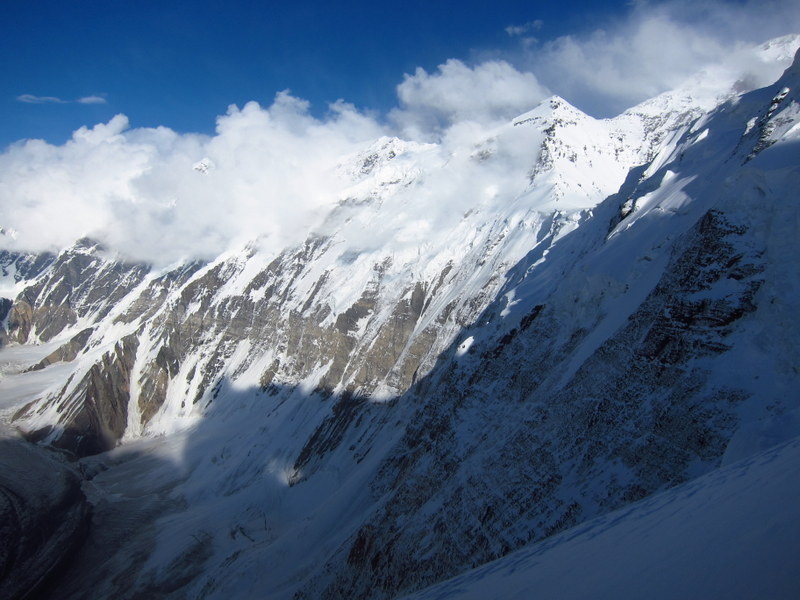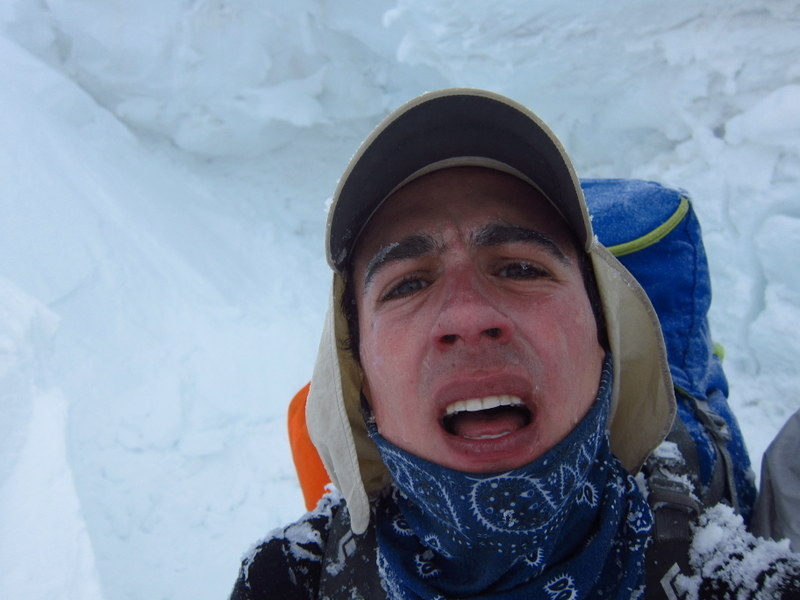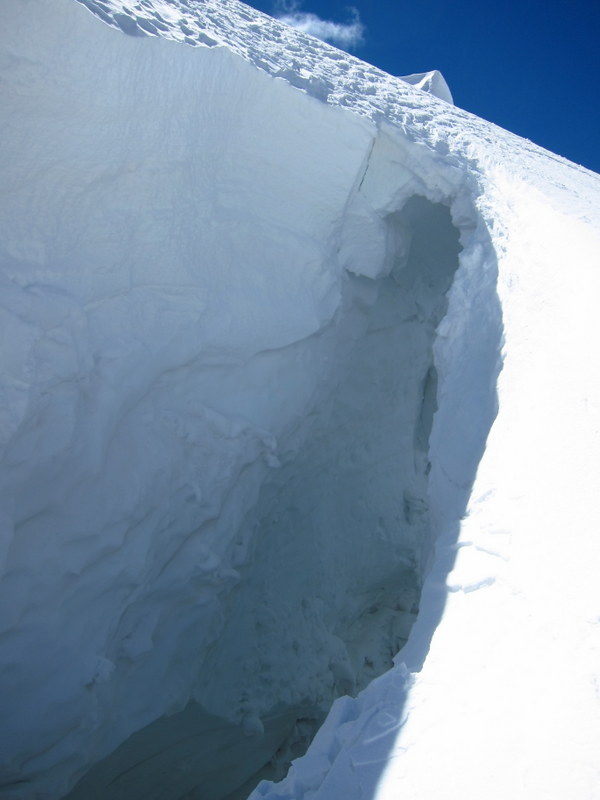I climbed steadily through the rotten rock, which at times became steep and fun scrambling. By early afternoon, I’d reached camp two, at 17,400 ft. From here, the route followed steady snow up a meandering ridge to 20,500 ft. Unfortunately, tracks from the large previous group were obscured, and fixed ropes were mostly buried. I plodded up variable snow, sometimes providing purchase, sometimes leaving me to plunge through. Though I was feeling relatively good, I knew the snow conditions weren’t going to allow me to reach the plateau at the top of the buttress, so I started hurrying to the 5800m (19,000 ft) camp before darkness fell. I made it to camp and quickly stomped out a tent platform before getting started melting snow and drying my boots.
The next day was surprisingly warm. By the time I finished packing up and boiling water, I was in just my base layer. Progress began impossibly slowly. I traversed to the right of some seracs, and had an incredibly frustrating time climbing a steeper section of absolutely bottomless snow. A few meters above, I reached the endless gentle slopes leading to the plateau. Unfortunately, the snow conditions were even worse. I took out the GPS and realized that I’d spent over two hours covering just 100m. After a few breaks, and some futile traverses across the broad rib looking for better snow, I decided to descend. I only had two more full days before I needed to be back in base camp, and the task ahead simply wasn’t a one-man job. I was just below 6000m. The route above meant crossing the almost certainly untracked and soft plateau, then the brutal slopes of Peak Dushanbe and the final stretch to the summit 1500m above. A huge team of over 10 had been thrashing up the mountain for nearly a week before me still without success. With little fanfare, I started back down the Borodkin.
BOOM! My head jerked to the right, expecting to see one of the huge seracs avalanching over the ramp. It really sounded like an explosion, but I knew better. Instantly, my other senses confirmed the obvious: several tons of ice and I were in free fall. The fall seemed to last forever. Every few meters, we would hit something, then continue collapsing. With each bump, I reassessed and changed strategy, somehow managing to stay mostly upright as I plunged deeper and deeper into darkness. Near the end of the ride, things took a big turn for the worse. Microwave-sized blocks of ice closed in on me, crushing first my legs and back, and then, my head. As we fell together, I fought, punching upwards with all my might. After an eternity, the motion stopped, and the ice closed in.
I swiftly descended more awful snow to the top of the rock buttress. There, I was able to raise base camp on the radio for the 1PM emergency check-in. I let them know of the situation and that I was descending. I’m not sure Igor grasped the severity of what happened: “OK, understand.” I descended the rock section methodically, and took a quick break at the top of the dreadful ramp. The thought of crossing it alone in the heat of the day was sickening. Rockfall near the start was almost constant. The snow bridges were rotten and awful. I traversed avalanche debris ever closer to the base of the wall to avoid the worst of the crevasses. I ran across the ramp in 18 minutes, and didn’t really feel at rest until I’d reached ABC on the other side of the Walter.
I briskly boulder-hopped back to base camp in an uneventful hour. At camp, I dropped my pack and met Alex, my French friend who’d seen the whole thing. Several climbers in base camp had been monitoring my progress, and they saw the plume of snow and crevasse open. As I gazed back up the Borodkin, my new gash smirked back as if to say, “It should have been.”
I’ve been climbing quite a while and I’ve never had an accident. Or should I say I’ve had one. Just to set a few things into place: I was climbing unroped on a section where this was common practice. Being alone didn’t make me fall into the crevasse but it certainly did have implications. The helmet was in my pack because I’d bypassed the areas threatened by rock and icefall.
I think this may have been the hottest day of the season. The same heat that made the snow conditions terrible for my ascent likely contributed to the unusual breaking of such an enormous snow bridge. In all, I sense that the Pamir may be more dangerous than normal this year. There was a tremendous amount of snow last winter, and it continues to snow quite a bit this summer.
I consider myself fairly safety conscious, and I’ve never taken a fall on snow or a lead fall on rock. The mountains involve many calculated risks, but I’ve never been so caught by surprise. It’s quite premature for me to discuss risk in mountaineering, but I’ll put a few thoughts down. I love the mountains. I’m not willing to die for a summit, but also unwilling to insulate myself from adventure, uncertainty and physical challenge. Mountains provide a particularly potent dose of reality from time to time, but those dangerous moments are always there even if we’re frequently kept in the dark about them. Walking back from lunch in Ann Arbor in April, a gust of wind knocked over a street light that shattered in my path. Urban life often conceals the true precariousness of life. No one says mountaineering isn’t dangerous. I’m very much aware that I may have a love for something that doesn’t love me back. Perhaps soloing 7000m peaks is a particularly committing and reckless way to explore, and it’s not something I necessarily intended to continue. I feel like I’m risking getting a bit defensive, and things are so fresh in my mind I don’t know if it’s worth it to say more. For the time being, I’m just going to enjoy what I have here, work a bit on my manuscript, and wait for the helicopter in a few days. My Pamir trip is over. It was a wild and wonderful ride.
Take care,
Hari
Hari Mix is an ASC Adventurer and experienced alpinist who is currently on a trip through Central Asia climbing several high altitude mountains and collecting data for a Microbe project. Hari is also a PhD Candidate at Stanford University and is primarily focused on Terrestrial Paleoclimate Research. This post was retrieved from Hari’s blog at https://hmix.org/



